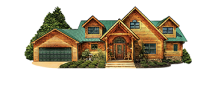There are numerous log home manufactures throughout the US and none of their packages are exactly the same. This makes it difficult for the buyer to determine and compare the value. Depending on the components included, there can be a vast difference in value.Primarily there are two variables. First, how much and what all is included and second, the quality of the material.
Basic vs. complete log home packages
Taking a look at one example of what all is included; the standard package for the 2007 square foot McKay model, with logs and windows only, has a value of $63,000 from our company. On the other hand, the more complete package for that same home with the timbered roof system, hardwood flooring, all the way down to finish nails and closet rods has a value of $224,000. Most advertised packages fall somewhere between these two. The second variable is the quality of the components in the package itself. Take windows as one example. One package may include a basic Anderson 200 series windows. Another company may include an upgrade to an Anderson 400 series with screens and grilles included. This for the same home will add $3000 or more value.
Log home lumber sourcing
For log home producers like Hochstetler Log Homes who are vertically integrated, the journey of your log home starts in the farmer’s wood lot. We buy the standing trees from them, and hire a contractor to cut them. Next, the logs get shipped to our sawmill where they get sawn into boards and cants (square timbers). Unique in that process is, we “kerf” the cants. This is a simple saw cut into the bottom of the logs to help control checks similar to cutting control cuts in concrete. After the logs are sawn, we end coat the lumber and put it on stickers, under cover. The cants are air dried for at least a year and the boards for several months.
Kiln drying for log homes
Once you place your order for a log home package the cants are put into a dry kiln in order to dry them down even further. Turning up the heat in the kiln to above 140 degrees assures that the logs are sanitized. This kills anything alive such as bugs and larva that may have entered the cant, plus it also helps set the pitch. Finally, they are milled, trimmed and graded into a tongue-and-groove stacking log. From there they are temporarily put in storage until the builder and/or client is ready to take delivery. Generally, we will send one truck load at at ime as the builder needs them. This way, the material isn’t lying around on thejob site where it can get damaged or even wet.
Sustainable log home practices and long-term value
On top of all this, every year we give away 1000’s of pine seedlings to farmers and land owners to plant. We try to match planting that many on our own treefarmas well. This is to assure sustainability and material for future generations to produce quality log homes.All these invaluable, behind the scenes processing steps, assures quality control, comfort and peace of mind but at the same time adds cost and value to your log home package. Hidden value that most buyers would fail to realize. At least not till many years later when problems start surfacing.
Log home upgrades
If we chose not to kerf our cants, it by itself would save the consumer $2500, or more on their package. However, you would experience more checking on the surface. You, as a potential log home owner will have to decide if the extra dollars will justify this quality improvement or not.Another big cost variation to packages is the quality of the roof system. Some companies will supply conventional rafters with a few decorative timbers and 7/16th OSB sheathing in their packages. Others like ourselves, will supply a post-and-beam structural timber roof system including a continuous blanket of 7-3/8 polystyrene insulation panels with OSB attached. This, for the McKay, amounts to an additional $17,000 value. Then it’s the type of components. Using the 2007 square foot McKay as an example, the 6” wide logs verses 8” is an additional $8135 value. Other items with more value include Douglas fir structural timbers versus yellow pine or white pine $16,500; standing seam metal roof versus shingles $13,500; and brand name metal such as choosing McELROY METALS versus a local roll former is double the cost. The list could go on and on. Another point of confusion is the different jargon that company’s use that many clients don’t understand. #1 dense KD DF timbers; stands for, that the timbers are dense a very strong, slow growing kiln-dried Douglas Fir with a number one and better grade. This is a subject, all by its own, which we will address in a later article. Sometimes companies advertise a completed turnkey modular log cabin, ready to put on your foundation when all it really is, is a double-wide with log siding and false corners, giving it the log home look.
Comparing log home packages & verifying manufacturers
Do your homework. Compare item for item. Comparing the final turn key build price will tell you more in the end, on the completeness of the package. Far more than what the package costs in itself.For quality comparison the most effective thing you can do is visit the log home manufacturers production facility. To see their log home models is important but nothing will tell you as much as seeing and observing their facility. If someone claims they air dry their logs for a year they will have a huge air-drying yard full of cants that you will want to see. If they Kiln-Dry their cants you will want to tour the kiln also. This is imperative, as those important steps are impossible without having those capabilities.









